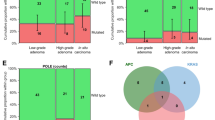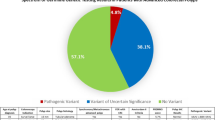Abstract
The malignant potential of colorectal adenomas highly correlates with their pathological characteristics, such as size, histology and grade of dysplasia. Currently, based on these parameters, adenomas are characterized as “non-advanced or advanced” and patient surveillance is adjusted accordingly. The aim of this study was to investigate the correlation between the KRAS mutations and characteristics of non-advanced and advanced colorectal adenomas for predicting the risk of increased malignant potential of adenomas that may influence the decision to offer follow-up endoscopic surveillance. We used a mutagenic polymerase chain reaction – restriction fragment length polymorphism method to determine KRAS mutations in 164 colorectal sporadic polypoid adenomas (51 non-advanced-, 113 advanced adenomas) and in 40 early colorectal carcinomas. The method of mutation detection was validated according to recommendation for KRAS mutation testing in colorectal carcinoma of the European Quality Assurance Program. The limit of detection of the assay was 3 % mutated DNA with a good reproducibility. Evaluation of pathological characteristics was performed according to European Guidelines for Quality Assurance in Colorectal Cancer Screening and Diagnosis. The morphological parameters of the adenoma such as size, histology, grade of dysplasia are highly correlated with one another: an increasing adenoma size raised the proportion of villous histology and degree of dysplasia (all p < 0.0001). KRAS mutations were detected in 31 % of the non-advanced adenomas, in 57.5 % of the advanced adenomas and in 62.5 % of the early carcinomas. Most mutations occurred at codon 12 rather than at codon 13 (72 %, 82 %, 76 % versus 22 %, 17 %, 24 %, respectively). There was no significant difference in association of KRAS mutation with age, gender, location among non-advanced-, and advanced adenomas and early carcinomas. KRAS mutation was found more often in tubulovillous and villous adenomas, whereas wild-type KRAS was observed more frequently in tubular adenomas (P < 0.0001) and there was an increased prevalence of KRAS mutations in larger adenomas (P < 0.0001). In this study KRAS mutation occurred with the same frequency in adenomas with low-grade (48 %) and high-grade (50 %) dysplasia. KRAS mutation is very strongly associated with a villous architecture and through villous component expansion, KRAS mutations may increase risk of tumor progression in sporadic colorectal polypoid adenomas.
Similar content being viewed by others
References
Jemal A, Siegel R, Ward E et al (2008) Cancer statistics, 2008. CA Cancer J Clin 58(2):71–96
Center MM, Jemal A, Ward E (2009) International trends in colorectal cancer incidence rates. Cancer Epidemiol Biomarkers Prev 18:1688–1694
Strul H, Kariv R, Leshno M et al (2006) The prevalence rate and anatomic location of colorectal adenoma and cancer detected by colonoscopy in average-risk individuals aged 40-80 years. Am J Gastroenterol 101:255–262
Carl CS, Ulrich L, Martin RB (1999) Sensitive detection of K-ras mutations augments diagnosis of colorectal cancer metastases in liver. Cancer Res 59:5169–5175
Nagorni A, Katic V, Zivkovic V, Stanojevic G (2004) Advanced colorectal adenoma. Arch Oncol 12(Suppl 1):59–60
Anke HS, Beatriz C, Meike W et al (2010) Identification of key genes for carcinogenic pathways associated with colorectal adenoma-to-carcinoma progression. Tumor biol 31:89–96
Barry ELR, Baron JA, Grau MV et al (2006) K-ras mutations in incident Sporadic colorectal adenomas. Cancer 106:1036–1040
Einspahr JG, Martinez E et al (2006) Associations of Ki-ras proto-oncogene mutation and p53 gene overexpression in sporadic colorectal adenomas with demographic and clinicopathologic characteristic. Cancer Epidemiol Biomarkers Prev 15:1443–1450
Fearon ER, Vogelstein B (1990) A genetic model for colorectal tumorigenesis. Cell 61:759–767
Pretlow TP, Brasitus TA, Fulton NC et al (1993) K-ras mutations in putative preneoplastic lesions in human colon. J Nat Cancer Inst 85:200–204
Quirke Ph, Risio M, Lambert R et al (2011) Quality assurance in pathology in colorectal cancer screening and diagnosis - European recommendations. Virchows Arch 458(1):1–19. doi:10.1007/s00428-010-0977-6
Winawer SJ, Zauber AG, Ho MN, O’Brien MJ et al (1993) Prevention of colorectal cancer by colonoscopic polypectomy. N Engl J Med 329:1977–1981
Vieth M, Quirke P, Lambert R et al (2011) Annex to Quirke et al. Quality assurance in pathology in colorectal cancer screening and diagnosis: annotations of colorectal lesions. Virchows Arch 458(1):21-–30
Segnan N, Patnick J, von Karsa L (2010) European guidelines for quality assurance in colorectal cancer screening and diagnosis, 1st edn. Publications Office of the European Union, Luxembourg
WHO (2000) Pathology and genetics of tumours in the digestive system. Carcinoma of the colon and rectum. In: Hamilton SR, Aaltonen LA (eds) World health organization international histological classification of tumours, vol 2. IARC, Lyon, pp 105–119
Abdulamir AS, Hafidh RR, Mahdi LK et al (2008) The interplay between p53 and p21 tumor suppressor proteins in the transformation of colorectal adenoma to carcinoma. Am J Immunol 4(2):14–22
Van Krieken JHJM, Jung A, Kirchner T et al (2008) KRAS mutation testing for predicting response to anti-EGFR therapy for colorectal carcinoma: proposal for an European quality assurance programme. Virchow Arch 453:417–431
Amicarelli G, Adlerstein D, Shehi E, Wang F, Makrigiorgos GM (2006) Genotype-specific signal generation based on digestion of 3-Way DNA junctions: application to KRAS variation detection. Clin Chem 52(10):1855–1863
Krypuy M, Newnham GM, Thomas DM et al (2006) High resolution melting analysis for the rapid and sensitive detection of mutations in clinical samples: KRAS codon 12 and 13 mutations in non-small cell lung cancer. BMC. Cancer 6:295
Brink M, de Goeij AFPM, Weijenberg MP et al (2003) K-ras oncogene mutations in sporadic colorectal cancer in The Netherlands Cohort Study. Carcinogenesis 24(4):703–710
Schoen RE, Gerber LD, Margulies C (1997) The pathologic measurement of polyp size is preferable to the endoscopic estimate. Gastrointest Endosc 46:492–496
Tsai FC, Strum WB (2011) Prevalence of advanced adenomas in small and diminutive colon polyps using direct measurement of size. Dig Dis Sci 56(8):2384–2388. doi:10.1007/s10620-011-1598-x
Rashid A, Zahurak M, Goodman SN, Hamilton SR (1999) Genetic epidemiology of mutated K-ras proto-oncogene, altered suppressor genes, and microsatellite instability in colorectal adenomas. Gut 44:826–833
Vogelstein B, Fearon ER, Hamilton SR et al (1988) Genetic alterations during colorectal-tumor development. N Engl J Med 319:525–532
Morris RG, Curtis LJ, Romanowski P et al (1996) Ki-ras mutations in adenomas: A characteristic of cancer-bearing colorectal mucosa. J Pathol 180:357–363
Eide TJ (1986) Risk of colorectal cancer in adenoma-bearing individuals within a defined population. Int J Cancer 15:173–176
McLellan EA, Owen RA, Stepniewska KA et al (1993) High frequency of K-ras mutations in sporadic colorectal adenomas. Gut 34:392–396
Jass JR, Baker K, Zlolec I et al (2006) Advanced colorectal polyps with the molecular and morphological features of serrated polyps and adenomas: concept of a’fusion’ pathway to colorectal cancer. Histopathology 49:121–131
Risio M (2010) The natural history of adenomas. Best Practice & Research Clinical Gastroenterology 24:271–280
Appelman HD (2008) Con: High-grade dysplasia and villous features should not be part of the routine diagnosis of colorectal adenomas. Am J Gastroenterol 103:1329–1331
Rex DK, Goldblum JR (2008) Pro: Villous elements and high-grade dysplasia help guide post-polypectomy colonoscopic surveillance. Am J Gastroenterol 103:1327–1329
Odze R (2008) A Balancing view: Pathologist-Clinician interaction is essential. Am J Gastroenterol 103:1331–1333
Nusko G, Sachse R, Mansmann U et al (1997) K-RAS-2 gene mutations as predictors of metachronous colorectal adenomas. Scand J Gastroenterol 32:1035–1041
Wang JY, Wang YH, Jao SW et al (2006) Molecular mechanisms underlying the tumorigenesis of colorectal adenomas: correlation to activated K-ras oncogene. Oncol Rep 16:1245–1252
O’Brien MJ, Yang S, Mack C et al (2006) Comparison of microsatellite instability, CpG island methylation phenotype, BRAF and KRAS status in serrated polyps and traditional adenomas indicates separate pathways to distinct colorectal carcinoma end points. Am J Surg Pathol 30:1491–1501
Risio M, Malacarne D, Giaretti W (2005) KRAS transitions and villous growth in colorectal adenomas. Cell Oncology 27:363–366
Ishii T, Notohara K, Umapathy A et al (2011) Tubular adenomas with minor villous changes show molecular features characteristic of tubulovillous adenomas. Am J Surg Pathol 35:212–220
Saini SD, Kim HM, Schoenfeld P (2006) Incidence of advanced adenomas at surveillance colonoscopy in patients with a personal history of colon adenomas: a meta-analysis and systematic review. Gastrointest Endosc 64:614–626
Calistri D, Rengucci C, Seymour I et al (2005) Mutation analysis of p53, K-ras, and BRAF genes in colorectal cancer progression. J Cell Physiol 204:484–488
Conflicts of Interest
The authors disclose no conflicts.
Author information
Authors and Affiliations
Corresponding author
Rights and permissions
About this article
Cite this article
Yadamsuren, EA., Nagy, S., Pajor, L. et al. Characteristics of Advanced- and Non Advanced Sporadic Polypoid Colorectal Adenomas: Correlation to KRAS Mutations. Pathol. Oncol. Res. 18, 1077–1084 (2012). https://doi.org/10.1007/s12253-012-9547-3
Received:
Accepted:
Published:
Issue Date:
DOI: https://doi.org/10.1007/s12253-012-9547-3




